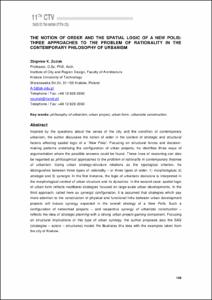Mostra el registre d'ítem simple
The notion of order and the spatial logic of a new polis: three approaches to the problem of rationality in the contemporary philosophy of urbanism
| dc.contributor.author | Zuziak, Zbigniew K |
| dc.date.accessioned | 2016-10-03T14:56:37Z |
| dc.date.available | 2016-10-03T14:56:37Z |
| dc.date.issued | 2016-07 |
| dc.identifier.citation | Zuziak, Zbigniew K. The notion of order and the spatial logic of a new polis: three approaches to the problem of rationality in the contemporary philosophy of urbanism. A: Virtual City and Territory. "Back to the Sense of the City: International Monograph Book". Barcelona: Centre de Política de Sòl i Valoracions, 2016, p. 199-214. |
| dc.identifier.isbn | 978-84-8157-660-3 |
| dc.identifier.uri | http://hdl.handle.net/2117/90411 |
| dc.description.abstract | Inspired by the questions about the sense of the city and the condition of contemporary urbanism, the author discusses the notion of order in the context of strategic and structural factors affecting spatial logic of a “New Polis”. Focusing on structural forces and decision-making patterns underlying the configuration of urban projects, he identifies three ways of argumentation where the possible answers could be found. These lines of reasoning can also be regarded as philosophical approaches to the problem of rationality in contemporary theories of urbanism. Using urban strategy-structure relations as the typological criterion, he distinguishes between three types of rationality – or three types of order: 1) morphological, 2) strategic and 3) synergic. In the first instance, the logic of urbanistic decisions is interpreted in the morphological context of urban structure and its dynamics. In the second case, spatial logic of urban form reflects neoliberal strategies focused on large-scale urban developments. In the third approach, called here as synergic configuration, it is assumed that strategies which pay more attention to the construction of physical and functional links between urban development projects will induce synergy expected in the overall strategy of a New Polis. Such a configuration of networked projects – and respective synergy of urbanistic construction – reflects the idea of strategic planning with a strong urban project gaming component. Focusing on structural implications of this type of urban synergy, the author proposes also the SAS (strategies – actors – structures) model. He illustrates this idea with the examples taken from the city of Krakow. |
| dc.format.extent | 16 p. |
| dc.language.iso | eng |
| dc.publisher | Centre de Política de Sòl i Valoracions |
| dc.relation.ispartof | International Conference Virtual City and Territory (11è: 2016: Cracòvia) |
| dc.rights | Attribution-NonCommercial-NoDerivs 3.0 Spain |
| dc.rights.uri | http://creativecommons.org/licenses/by-nc-nd/3.0/es/ |
| dc.subject | Àrees temàtiques de la UPC::Urbanisme |
| dc.subject.lcsh | City planning |
| dc.subject.other | Philosophy of urbanism |
| dc.subject.other | Urban project |
| dc.subject.other | Urban form |
| dc.subject.other | Urbanistic construction |
| dc.title | The notion of order and the spatial logic of a new polis: three approaches to the problem of rationality in the contemporary philosophy of urbanism |
| dc.type | Conference report |
| dc.subject.lemac | Urbanisme |
| dc.subject.lemac | Morfologia urbana |
| dc.identifier.doi | 10.5821/ctv.8058 |
| dc.rights.access | Open Access |
| local.citation.contributor | Virtual City and Territory |
| local.citation.pubplace | Barcelona |
| local.citation.publicationName | Back to the Sense of the City: International Monograph Book |
| local.citation.startingPage | 199 |
| local.citation.endingPage | 214 |
Fitxers d'aquest items
Aquest ítem apareix a les col·leccions següents
-
11th Congress Virtual City and Territory, Krakow, 6-8 July 2016 [121]
Back to the sense of the city


